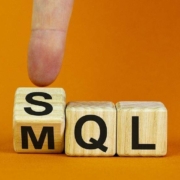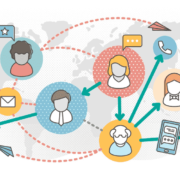Senior Living Referral Sources: Outreach & Engagement Strategies
While we spend a lot of time in our blog talking about digital marketing strategies for attracting quality prospects, we should never underestimate the power of loyal referral sources. Think of them as your “boots on the ground” who can help supplement your online efforts. Wondering how to reach and engage with senior living referral sources? We got you covered.
Types of senior living referral sources to go after:
1. Healthcare referrals.
Referrals that originate from healthcare providers offer a couple of key benefits. First, the sales cycle is usually much shorter since these tend to be needs-based referrals. And because a high level of trust usually exists between provider and patient, the sale is often much easier to make on your end. It’s not unlike asking a trusted friend for a referral for a general contractor—the same concept applies here. If a person’s doctor recommends your senior living community, that referral will hold a lot of sway.
Bottom line: Actively engaging with people in healthcare will be time well spent. Think beyond primary care physicians, too. Anyone who works with older adults (or adult children) can be a focus of your outreach: rehab providers, geriatric specialists, cardiac/pulmonary specialists, social workers, discharge planners/coordinators, and providers of home care services, just to name a few.
2. Friend and family referrals.
There’s nothing more compelling than a personal referral from a happy resident living in your community. If you don’t already offer an incentive, like a rent credit for referrals that result in a move-in, start one ASAP. “Make Your Friends Your Neighbors” campaigns work well, provided they are well executed. (We can help with that.)
3. Trusted advisors (non-healthcare).
Families often consult with financial advisors, elder-law attorneys, and/or private geriatric care managers (like a private college advisor to guide everyone through the decision process). These trusted relationships are highly valued.
4. Competitors. (Yes, really!)
Sometimes “competitors” can be “complements” as long as they offer a different niche. For example, active adult and independent living communities can refer to assisted living and memory care communities when residents need more support than they can provide (and vice versa!). Another example: a Kosher community will be able to refer prospects that are not aligned with that lifestyle/affiliation.
Even with direct competitors, situations exist where a prospect’s “non-negotiable” will be a barrier to moving in. In this case, it’s in everyone’s best interest to recommend the family to another community. (We’re firm believers in what goes around, comes around. So if your community refers prospects to other communities, eventually the favor will be returned.)
5. Grassroots groups.
Ultimately, senior living communities are very local, so building solid relationships with local organizations will always be a wise move. Think first responders, like EMTs (since they know who is unsafe at home), the Chamber of Commerce, houses of worship, and so forth.
Tips for engaging your senior living referral sources
Senior Living Referral Sources: Healthcare
Find ways to make their jobs easier. For example, create a “Rapid Referral” program to simplify steps. Clearly outline your admission criteria so they are not frustrated with denials, guarantee a response timeframe (e.g., “We will do an assessment within X hours of your referral”), make a decision quickly, and if you have to deny a move-in, explain why.
Recognize their contributions. Celebrate them on special healthcare-related days, like National Nurses Appreciation Day in May or Social Work Month in March. (And that’s just the beginning—check out this resource for other ideas.) Let them know that they make a difference.
Add value to their day-to-day lives and careers. Bring CEU programs/speakers to them (and pay for their credits) or offer space/use of your community for a team event.
Offer them something fun. Bring an ice cream truck around to referral sources on a hot summer’s day. Dress up on Halloween and hand out treats, bring chocolate-covered strawberries on Valentine’s Day, and if you can find out when their annual state survey is, bring a Stress Buster Basket with treats and a big bottle of Advil!
Say thank you on the regular. Get some branded latte cups with coffee samples and imprint them with your logo and “Thanks a Latte!” to acknowledge a referral. Also, provide a follow-up note to let them know how great a referred resident is doing—your referral sources care!
Senior Living Referral Sources: Friends & Family
Make it worth their while. Provide an exciting incentive for referring friends or family, like a rent credit for the loved one currently living in your community.
Make it easy for people to participate in your referral program. Offer a variety of ways for people to make the referral (e.g., phone, email, landing page on your website). Don’t make people jump through hoops—the only info you need is the current resident making the referral and the contact info for the person they’re referring to your community. Make sure you have a good backend system for keeping track of this info so that you can award rental credits in a timely manner.
Promote your referral program regularly. You always have new people moving in. Not to mention longer-term residents and their families need the occasional reminder. Go beyond the basic flyer. Instead, order door hangers and tent cards for the dining room and common areas. Have a vibrant pull-up banner in the lobby and create eye-catching inserts that can go into monthly billing statements. In addition, promote the program by email and link to a landing page that outlines the program basics and allows people to refer someone right then and there.
Host monthly/quarterly family nights and talk up the program and the incentive. Some communities make a presentation of a giant check for referrals. Take pictures of your senior living events and share them on social media and in newsletters to reach a larger audience.
Senior Living Referral Sources: Trusted Advisors
Build a referral network. Elder law attorneys, real estate professionals, downsizing experts, geriatric care managers, life insurance agents, accountants/CPAs, financial planners, and the like work directly with your target audience and their families. All of these service providers can be excellent sources of referrals. And remember, the best way to get referrals is to give referrals. This is exactly what networking groups like Business Networking International (BNI) promote with their “givers gain” philosophy.
Offer opportunities for trusted advisors to speak, educate, participate on a panel in your community. Cross-promoting your services is an excellent way to support trusted advisors and for them to support you.If you help them grow their business, they will return the favor. This strategy is also a smart and easy way to find topics for your monthly in-person or virtual events, newsletter, guest blog posts, podcasts—you get the idea.
Senior Living Referral Sources: Competitors
Foster trust and build relationships with competitors. This can be tricky since not everyone plays well together, but you should still make the attempt. Tour their communities and invite them to tour yours. Talk about your differentiators, your ideal prospects, and those you can’t accommodate. Regarding the latter, this could be based on services offered, price point, religious affiliation, and/or special needs, such as special diets.
Senior Living Referral Sources: Grassroots Groups
Get out and attend all community events. This is a great activity for sales teams. Attend health fairs, fundraisers, and school booster programs. Sponsor a local sports team—and bring residents with you! Have your community’s bus in the parade and at outdoor concerts. Become part of the community and have the community see that your residents are out and about and having fun! Participate in back-to-school backpack drives, food drives, clothing drives, and the like. And, of course, make sure you have plenty of branded material at the ready.
Offer community spaces for meetings, clubs, groups, piano recitals, art shows. This can be another great way to support local organizations and give locals a bird’s-eye view of your community.











